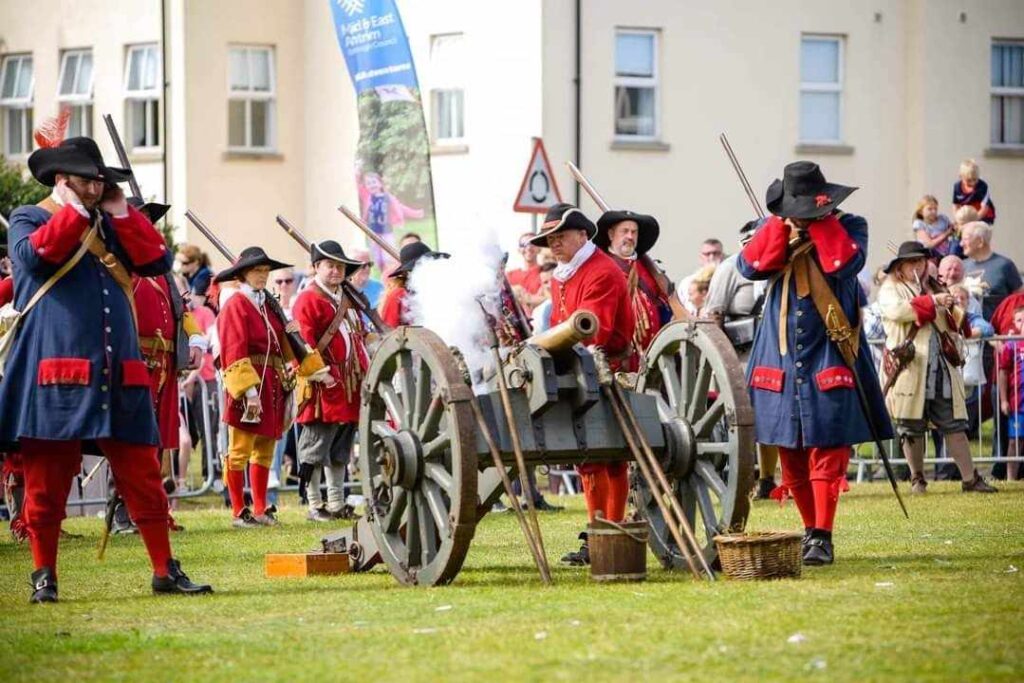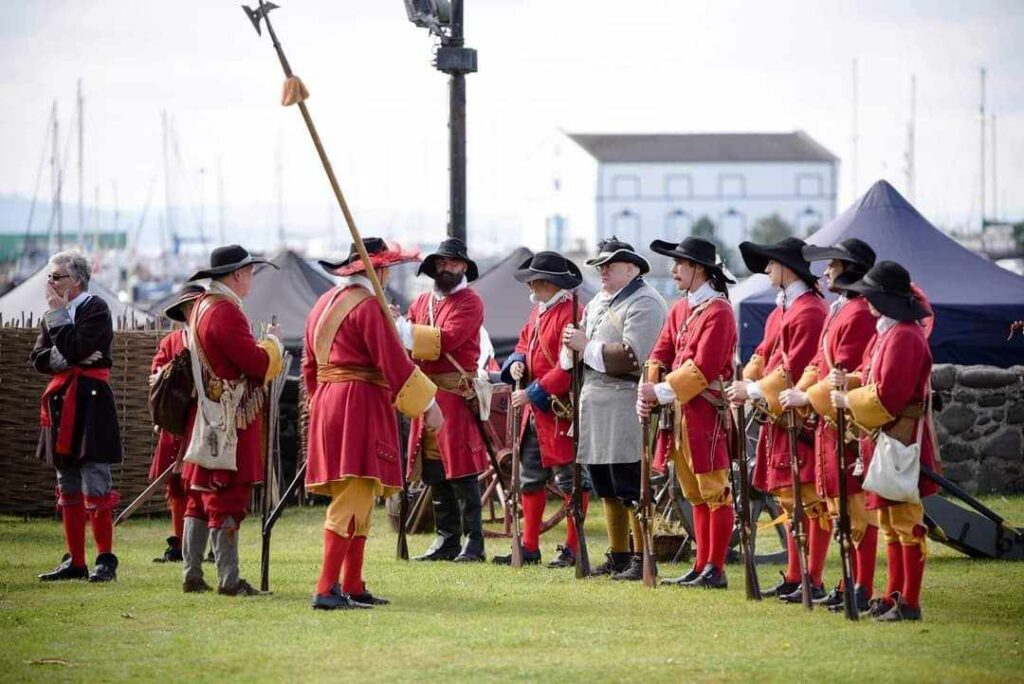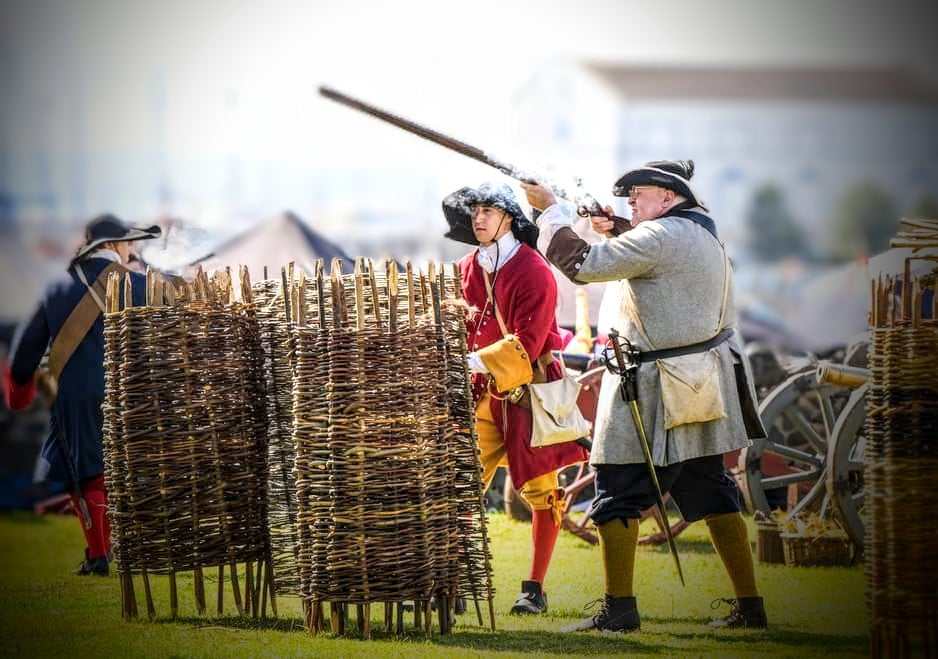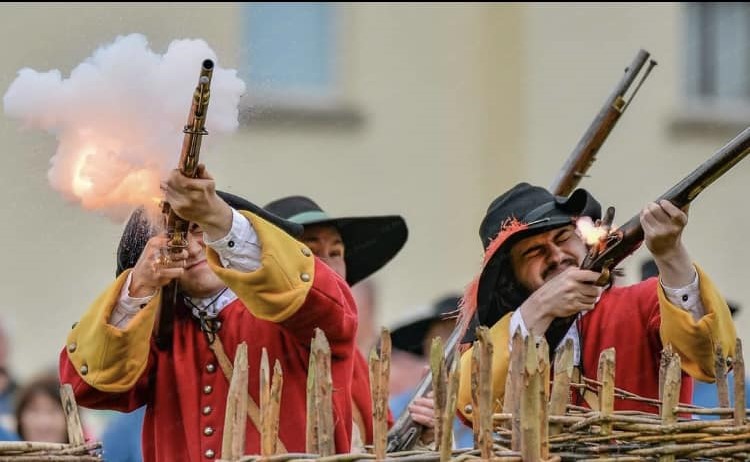Following the Break of Dromore on the 14th March 1689, the east of Ulster was firmly under the control of the Jacobites, commanded by Lieutenant General Richard Hamilton. This included the coastal town of Carrickfergus, situated along Belfast Lough (known as Carrickfergus bay in the 17th century). However, this all changed following the Jacobite failures to capture Derry and Enniskillen, and the Williamite victory at the Battle of Newtownbutler. This allowed the Williamite General, The Duke of Schomberg to act offensively against the Jacobites in Ulster. Schomberg’s army would land at Bangor Bay on the 13th August. His flag onboard the Cleveland, was raised, signalling for his troops to disembark. Some confusion ensued regarding the artilerry convoy, having reamined put in Ramsay Bay, Isle of Man. It wasn’t until HMS Antelope departed Belfast Lough, informing them to make hast and meet Schomberg’s forces in Bangor Bay. Once arrived, the total sum of the Williamite forces incuded; 5 regiments of English cavalry, 9 battalions of English infantry and 1 regiment of French Huguenots. Much to the surprise of the Williamites, they landed unopposed. Given the Jacobite garrisons in Carrickfergus, Bangor and Belfast, their surprise is most understandable. The following day was spent with much preparation for the incoming conflict with the Carrickfergus garrison. News had reached the Jacobites at Carrickfergus wiith a siege imminent, the Jacobites spent the week of the 14th August carrying out a scorched earth policy, to torch the suburbs surrounding the town and the surrounding areas of Carrickfergus,denying the Williamite army resources and defending cover. On the 15th Schomberg would respond by sending 250 cavalrymen from the Lord of Kingston’s regiment investigate the situation in Belfast and Lisburn. Subsquently, Colonel Henry Wharton’s infantry battalion took hold of Belfast, whilst on the 16th men from the Earl of Drogheda’s regiment under the command of Lieutenant Colonel Toby Caulfield arrived in Antrim town to find it deserted. Schomberg would arrive, and remain in Belfast until 19th August, securing communications with Bangor where the fleet base remained. This further compounded the difficulties already facing the Jacobites, with the Western Protestant Army having stood their ground at Derry and Enniskillen, and with a second Williamite army now in the picture

. Given the strong position of the Williamites in the north-west and a an ever stronger presence in the North East, the northern Jacobite commander and Governor of Carrickfergus, Colonel Thomas Maxwell ordered a general retreat to Newry. Maxwell would leave a garrison at Carrickfergus, headed by one battalion of Colonel Charles MacCarthy More and 9 companies of Cormac O’Neill’s regiment. On the 20th, Schomberg’s force, comprising 5 battalions, set forth for Carrickfergus. Additionally, they were joined by 16 troops of Enniskillen horse, forming an advanced guard of Kirke’s forces. With a bleak situation turner ever bleaker, their orders were clear; stall Schomberg’s advancing army. Schomberg was eager to end hostilities in Carrickfergus as quickly as possible, wishing to arrive in Dublin before winter. He would quickly instigate negotiations with Carrickfergus’ garrison, beating the drum and calling for surrender. A parlay was granted, with MacCarthy More requesting they be able to send a letter to King James II requesting advice. Schomberg denied the request, citing it as nothing more time wasting. Shortly thereafter, the Jacobite garrison’s artillery commenced fire, with one round taking out Schomberg’s personal tent. Fortunately, for Schomberg, he was not present, attending other duties in camp. Fighting continued throughout the rest of the day, and through the night into the 21st, with the Williamite sappers digging trenches in a bid to move closer towards the town walls. Additionally, the Williamite artillery would begin firing upon the castle itself. Heavy canoon and mortar bombardment continued into the following day. To add to the woes of the defending Jacobites, further Willimaite reinforcements arrived at the White House, a short distance from Carrickfergus. A further 4 battalions of infantry, 1 of dragon and 1 of cavalry were included within this band of reinforcements. A second parley was arranged on the 23rd, this time Macarthy More requested that the Jacobite garrison be allowed to surrender under the full honours of war. Schomberg once again rejected their request, ordering an unconditional surrender.



The Willimaites suffered problems of their own; first engineer Captain Jacob Richards was wounded and was removed from the siege trenches. Schomberg himself was required to step up to the plate, given that no one else had any experience conducting siege warfare, and not to mention his many years experience fighting on the continent. As a result of Schomberg’s orders, the guns on Windmill Hill took aim at the castle from the west, and the North Gate. Furthermore, orders were given to fire upon Lord Donegal’s house, as it had been reveled that it had been taken over by the Jacobites who had placed cannon upon it. On the 24th, a man known as “Mr Spring” escaped from the town and reported directly to Schomberg a number of interesting develoopments within the walls. The most important piece of information he relayed was that many within the garrison were calling for surrender, highlighting the very low stores of gunpowder. The situation was so dire that the garrison had to resort to using lead from the roof to make musket balls. The only obstacle in preventing this surrender was Governor MacCarthy More and Colonel Owen MacCarthy. To further compound the besieged wishes for surrender, a breach had been made at the North Gate of the town. Furthermore, Schomberg gave orders for the Royal Navy vessels in Carrick harbour to commence bombardment. On the 27th August, with the Williamite regiments poised to make an assault upon the breach, the white flag was flown from the Jacobite garrison.The Jacobites had held out for as long as possible. To a certain extent, the Jacobites achieved the original objective laid before them by Colonel Maxwell in stalling the Williamite advance. Schomberg who was most eager to depart from Carrickfergus, reversed his earlier decision, and permitted the Jacobite garrison the full honours of war, allowing them to march to the nearest Jacobite garrison at Newry and Charlemont; “The Garrison consisted of near Two thousand Men, and though at the first Summons sent them by the Duke of Schom∣berg, they were so stout as to refuse to hearken to any Conditions of Surren∣der, yet their Courage not continuing long, they accepted of the Terms of Marching out with Colours flying Arms, and Drums beating, &c. and to go to Charlemont”. They set forth on the 28th, being accompanied by their families, under an escort of Williamite cavalry of Colonel John Coy’s regiment of horse. The escort made it no further than 2km before the Jacobites were beset upon by Protestant civilains in retaliation for the injustices they suffered under the Jacobites. Schomberg himself was forced to enter the ensuing choas, pistol in hand, to prevent a potenital massacre. With Sir Henry Ingoldsby’s battalion left in Carrickfergus, Schomberg would attempt to reach Dublin before Winter set in. Such was not to be, having to make Winter quarters at Dundalk.
Bibliography
Childs, J. (2007) The Williamite Wars in Ireland. London: Bloomsbury Publishing PLC.
Maguire, W.A. (1990) Kings in conflict: The revolutionary war in Ireland and its aftermath, 1689-1750. Belfast:
Blackstaff Press.
Pestana, C.G. and Salinger, S.V. (2021) ‘Anon., a full and true account of the besieging and taking of Carrickfergus
by the duke of Schomberg (1689)’, The Early English Caribbean, 1570–1700, pp. 383–385.
doi:10.4324/9781003113027-38.
Story , G.W. (1691a) An Impartial History Of The Wars In Ireland
Images kindly provided by Oscar Spence
Leave a Reply
You must be logged in to post a comment.